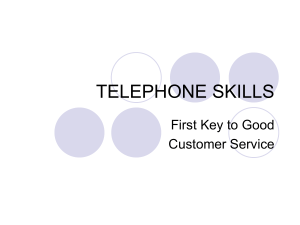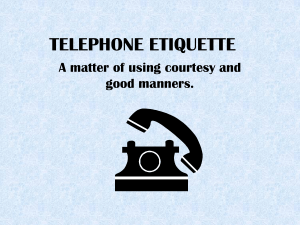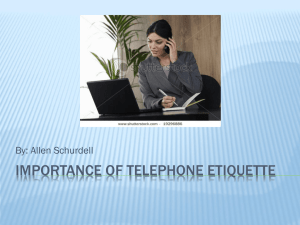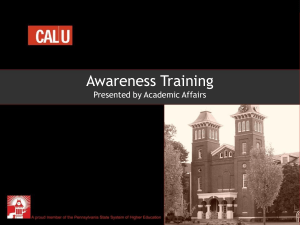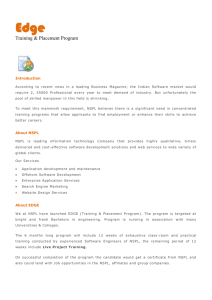2 IR Presentation - Texas Suicide Prevention
advertisement
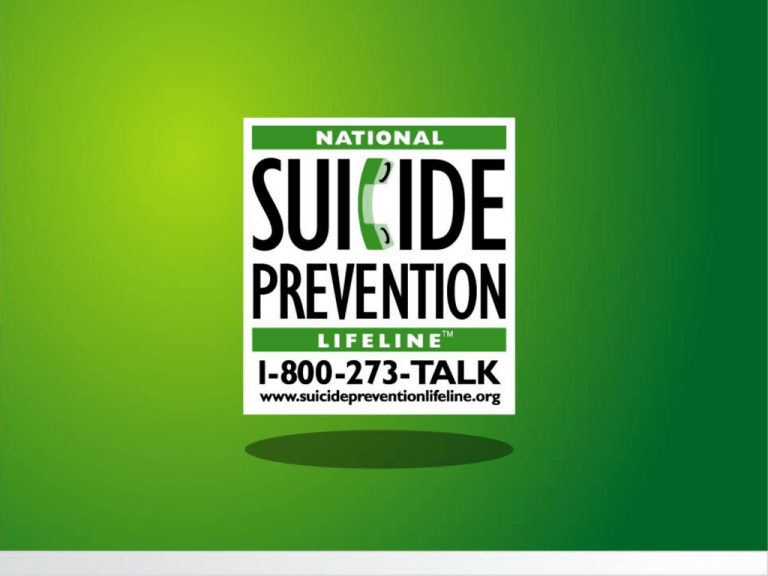
NSPL’S MISSION To effectively reach and serve all persons who could be at risk of suicide in the United States through a national network of crisis call centers. NSPL Administrator and Partners • Link2Health Solutions, Inc.— wholly owned subsidiary of MHA of NYC ; grant since Sept 2004 • Partners: National Assoc. of State Mental Health Program Directors (NASMHPD; since 2004) MHA of NYC (since 2005 when grant transferred to subsidiary) Living Works (2006-ongoing) WHERE ARE LIFELINE’S CENTERS LOCATED? How the NSPL Works • Caller dials 800-273-TALK or 800SUICIDE • Calls are free and confidential • NEAREST of 143 CENTERS (all are independently operating agencies) - Listen, Assess - Support, Refer or Link to services • Back-up centers to assure all calls answered • >57,000 calls per month (JULY 2009) Veterans Suicide Prevention Hotline 1-800-273-TALK, Veterans Press 1 • JULY 2007: VA AND SAMHSA LAUNCH FIRST NATIONAL SUICIDE HOTLINE FOR VETERANS • CALLS ROUTED THROUGH 800273-TALK (press 1) • 24-7 ACCESS TO TRAINED COUNSELORS at VA • NSPL CENTERS BACK-UP SERVICE • > 10,000 calls per month NSPL Advisory Bodies ConsumerSurvivor Subcommitte e SAMHSA Lifeline Network Centers Steering Committee Standards, Training & Practices Subcommitte e Helping Callers at Imminent Risk of Suicide Values, Policies and Guidelines NSPL: Why the Need For EI Policies and Guidelines? – Procedures for life-saving central to suicide hotlines – Variability in network center approaches require some uniform guidelines – Research from Mishara, Gould & Kalafat – Suicide Risk Assessment Standards = Need for Intervention Guidelines Development of Values, Policies and Guidelines: Lifeline Process • Review and Discussion Towards Policy/Guideline Development – CTS meetings (10/2006 on) – Steering Committee meetings (11/2006 on) – AAS EI workshops with crisis centers (2006 & 2007) – Legal review: Link2Health and SAMHSA – Background paper submitted to SAMHSA for final review (2009) NSPL Values Regarding Emergency Intervention The National Suicide Prevention Lifeline promotes: • Taking all action necessary to secure the health, safety and well being of the individuals it serves • Use of least invasive course of action • Collaboration with community crisis and emergency services Definition: Imminent Risk • When the Center Staff responding to the call believe, based on information gathered during the exchange from the person at risk or someone calling on his/her behalf, that there is a close temporal connection between the person’s current risk status and actions that could lead to his/her suicide……that is, if no actions were taken, the Center Staff believe that the Caller would be likely to seriously harm or kill him/her self. Definition: Imminent Risk (cont.) …Imminent Risk may be determined if an individual states (or is reported to have stated by a person believed to be a reliable informant) both a desire and intent to die and has the capability of carrying through his/her intent (see NSPL Standards). Helping Callers at Imminent Risk of Suicide • Policy and Guidelines for Telephonic Practices – Nine supporting guidelines • Policy for Establishing and Maintaining Collaborative Relationships with Local Crisis and Emergency Services Policy and Guidelines for Telephonic Practices Center Staff shall actively engage Callers and initiate any and all emergency intervention measures necessary— including active rescue—to secure the safety of Callers determined to be attempting suicide or at Imminent Risk of suicide. Guideline #1 Active Engagement • Actively engage callers • Establish rapport • Promote the caller’s collaboration Definition: Active Engagement • Intentional behaviors undertaken by Center Staff to effectively build an alliance with the Callers at Imminent Risk towards mutual understanding and agreement on actions necessary to successfully reduce Imminent Risk or accept medical interventions when the person is in the process of a suicide attempt. Background: Active Engagement Mishara et al (2007) analysis of 18 network centers showed: • In 15.6% of monitored calls at least one helper rating related to support was unacceptable • In 10/33 calls where a suicide attempt was in progress helpers did not try to engage the caller to stop the attempt Guideline #2 Least Invasive Intervention • Consider involuntary emergency interventions as a last resort • Seek collaboration • Include the caller’s wishes, plans, needs and capacities towards acting on his/her own to reduce his/her risk of suicide Background: Least Invasive Intervention • Currently 62% of NSPL center policies explicitly address “least invasive interventions” • Study of 8 centers (Gould et al, 2007): – nearly 12% of the callers spontaneously reported that the call “prevented them from killing or harming themselves” – Of 44 who reported a “lifesaving effect”, only two received emergency rescue • NSPL attempt survivor focus group: – “I am less likely to feel that a call to 911 saved my life as much as, say, just being listened to” Background: Least Invasive Intervention NSPL attempt survivor focus group: – “I am less likely to feel that a call to 911 saved my life as much as, say, just being listened to.” Example: Least Invasive Intervention • Obtaining agreement from the Caller – to take actions on his/her own behalf – to involve a significant other – to a three-way call with a treating professional – to receive an evaluation in the home by a mobile crisis/outreach team • Securing transportation to ER • Contacting public safety officials to facilitate a home visit Guideline #3 Life-saving Services for Attempts in Progress • Ensure caller receives emergency medical care if attempt is in progress • Make reasonable efforts to obtain caller’s consent • Consent is not necessary in order to initiate emergency rescue Background: Life-saving Services for Attempts in Progress • Inconsistent emergency intervention • Gould et al (2007) – evaluated 1,085 calls at 8 centers – 54 of 88 cases (61.4%): no rescue sent when suicide attempt in progress Background: Life-saving Services for Attempts in Progress • Mishara et al (2007) – listened to 2,611 calls at 16 centers – 33 cases: suicide attempt in progress • 6 cases emergency services sent • 8 cases caller stopped attempt • 9 cases caller refused help and no emergency services sent • 10 cases no attempt to have caller stop & no emergency services sent Guideline #4 Active Rescue • Initiate emergency rescue if a caller is at Imminent Risk of suicide but is unwilling/ unable to take actions to prevent his/her suicide Definition: Active Rescue • Actions undertaken by Center staff that are intended to ensure the safety of individuals at Imminent Risk or in the process of a suicide attempt. “Active” refers to the Center staff’s initiative to act on behalf of individuals who are in the process of an attempt or who are determined to be at Imminent Risk, but who, in spite of the helper’s attempts to actively engage them, are unwilling or unable to initiate actions to secure his/her own safety. Background: Active Rescue • Reasons for instituting a network guideline Choice to contact service – Cognitive constriction – Ambivalence – Significant others – Similar to AAS active intervention • 99% of centers practice a form of ‘active intervention’ • Guideline #5 Third-Party Callers • Actively engage the third-party caller towards determining the least invasive, most collaborative actions to ensure the safety of the at-risk individual – Consider third-party anonymity Background: Third Party • Data from 4 network centers: – 8.3% of calls from 3rd party 81% of network have a policy to actively respond to third parties • Concern regarding possible increased risk • Recommended Procedure: Third Party • Whenever possible, gather the following information from the third party caller: – – – Relevant information in the individuals risk status Contact information of the third party caller and relationship to person at risk Obtain contact information for the person at risk Recommended Procedure: Third Party Facilitate three way call with third party and person at risk • Facilitate three way call with third party and treatment professional • Confirm that third party is willing/ able to take actions to reduce risk: • – – – – – Remove access to weapons Maintain close watch Escort to treatment Collaborate with MCT Use information provided Recommended Procedure: Third Party Anonymity • NSPL recommends only preserving anonymity in those unusual situations when: – – To reveal the identity of the third party may aggravate risk to either third party or other (e.g. victim of domestic violence) The identity is less relevant than the report of a clear and present risk (e.g. stranger reports a person on a bridge) Guideline #6 Supervisory Consultation • Supervisory staff available for consultation during all hours of center operation – Includes staff that regularly act in a managerial or training capacity, with knowledge of the most current policies and procedures….Peers (with no other official designation or routine role as staff supervisor or trainer) acting as consultants are not sufficient to meet this requirement. Guideline #7: Caller I.D. • Some method of identifying caller’s location in real time – Caller I.D. – Real Time Call Trace Background: Caller ID • Gould et al (2007) evaluation of eight centers found crisis staff unable to initiate recue for 8 of 54 callers due to no caller ID • 91% of NSPL centers currently use caller ID as a “tool to rescue” Guideline #8: Confirmation of Emergency Services Contact • When center initiates active rescue, confirm that emergency services have made contact with at-risk individual Background: Emergency Service Contact • Currently 54% of NSPL centers can confirm emergency contact • LifeNet NYC data for 1997 – 1999 showed: – 33% of active rescue calls did not result in transport Example: Emergency Service Contact • Steps to confirm emergency service contact may include: Staying on – Contacting – Contacting – Contacting – Contacting – Contacting – line with caller local PSAP ED or MCT treating professional caller directly significant other Guideline #9: Follow-Up When Emergency Services Contact is Unsuccessful • Take additional steps to address the safety of the at-risk individual when emergency services do not make contact Policy for Establishing & Maintaining Collaborative Relationships with Local Crisis & Emergency Services Centers shall establish collaborative relationships (formal and/or informal) with one or more crisis or emergency service providers in their community Example: Crisis & Emergency Services • Police departments • Fire departments • County sheriff offices • Mobile crisis/psychiatric outreach teams • Hospital emergency departments • 911 • Emergency Medical Services Example: Formal/Informal Relationships • Formal – Cooperative agreement – MOU – Relationship officially authorized by a local government entity – Intra-agency policy • Informal – Regular communications with local emergency or crisis services – Exchange of education materials – Training of local emergency staff CRISIS CENTER EMERGENCY RESCUES: A MODEL for INFORMATION EXCHANGE BETWEEN THE CALLCENTER, 911 & EMERGENCY DEPARTMENTS IN NYC MOU ISSUED BY CITY TO ALL ENTITIES: IF LIFENET NYC CALLS 911, then… 911 gives Lifenet a ref. # for call Lifenet calls for disposition, using ref # Was the caller transported or not? If transported, to which hospital ED? Lifenet calls ED for admission status Lifenet reports to City about transports and admissions PURPOSE OF M.O.U. • Track continuity of care for high risk callers in need of emergency service • 1997-1999: 33% of 911 calls not transported (Lifenet sends mobile teams to follow-up) Half of transported callers not admitted to the hospital NEW LIFENET PROTOCOL, 1999 TO IMPROVE E.D. ASSESSMENT OF TRANSPORTED CALLERS, LIFENET WILL : • Fax Caller information about risk to receiving ED • Call the ED staff to ensure fax was received Need for Confirming Emergency Service Contact (Example) LifeNet NYC Transports and Hospital Admission Rates for Callers Needing Emergency Rescue, 1997-2004 70 P E R C E N T A G E S 60 50 Not Transported 40 Admitted Not Admitted 30 20 10 0 1997 1998 1999 2000 2001 2002 2003 2004 639 complete records for rescue calls, 1997-2004 LIFENET E.D. PROTOCOL EFFECTS 1997-2004 More risk information from Lifenet to E.D. resulted in: •52% increase in admission rates 1st year after protocol implementation •Trend towards more admissions each year •116% higher admission rates in 2004 compared to 1998 Will 911 Call Centers Provide Information to Crisis Centers? National Emergency Number Association (NENA): • Few 911 centers routinely report externally on transport status • Some fear it is a HIPAA violation • Would require crisis centers developing local collaborations with 911 • A NENA Standard Operating Procedure (SOP) for Lifeline centers would help collaborations to develop NSPL Confidentiality Statement • NSPL is committed to maintaining the confidentiality of callers to the network. • The confidentiality of any information disclosed during a call to one of the NSPL centers will be upheld at all times. The only potential exception to preserving confidentiality is in the circumstance in which an individual is at imminent risk of injury or death. WHAT HIPAA SAYS: “A covered entity can…use or disclose protected health information, if the covered entity…believes the use or disclosure: (I)(A) Is necessary to prevent or lessen a serious and imminent threat to health or safety of a person or the public; and (B) Is to a person or persons reasonably able to prevent or lessen the threat; or (ii) Is necessary for law enforcement authorities to indentify or apprehend the individual”…. OCR/HIPAA Privacy/Security Enforcement Regulation Text, 45 CFR 164.512(j) INFO EXCHANGE FOR CARE CONTINUITY : • Standard practice for psychiatrists to counsel family or caretakers of potentially self-harming persons about risks, potential methods, and actions to reduce risk • Gross v. Allen, 1994: Caretakers of patients with a history of self-harm are legally responsible for informing the individual’s new caretakers (not a Tarasoff-like “Duty to Warn”, but “common-sense practice”) Robert Simon, M.D., Psychiatric Legal Expert, 2004 NENA S.O.P. DRAFT • Information about Lifeline and its network of centers • Encourages 911/crisis center collaboration for continuity of care • Adresses HIPAA as nonprohibitive • Specifies recommended procedure NENA-LIFELINE S.O.P. RECOMMENDED PROCEDURE •911 Center devise method for communicating disposition status to crisis center •Provide information about whether caller was seen and assessed (“contact made”) by rescue service •If caller was transported for further evaluation, communicate name of receiving facility NEXT STEPS FOR NENA -LIFELINE S.O.P. • Feb 2009: Lifeline met with NENA Ops. Council • 2nd draft being re-drawn with workgroup of 911 Directors • Likely to be completed by end of 2009 • S.O.P to be disseminated to all 911 and Lifeline centers in 2010 Timeline for Lifeline Policies & Guidelines Implementation • Policies, background paper, and center guidelines distributed • One year for implementation • Calls to individual centers to review implementation and assess readiness • Ongoing TA to individual centers • Webinars • Blog • Sample guidelines IMPLICATIONS of LIFELINE POLICIES AND GUIDELINES FOR HELPING CALLERS AT IMMINENT RISK OF SUICIDE WILL THEY CHANGE HELPER PRACTICES? • Ongoing evaluation • Lifeline TA: ASIST Trainings (ongoing) Computer simulations (2011?) • Quality Improvement Monitoring Standards (2011?) WILL THEY CREATE MORE OR LESS CALLS TO 911 FROM CRISIS CENTERS? WILL THEY AFFECT STANDARDS OF CARE IN BEHAVIORAL HEALTH OVERALL? CONTACT INFORMATION John Draper, Ph.D. Director National Suicide Prevention Lifeline (212) 614-6357 jdraper@mhaofnyc.org www.suicidepreventionlifeline.org

